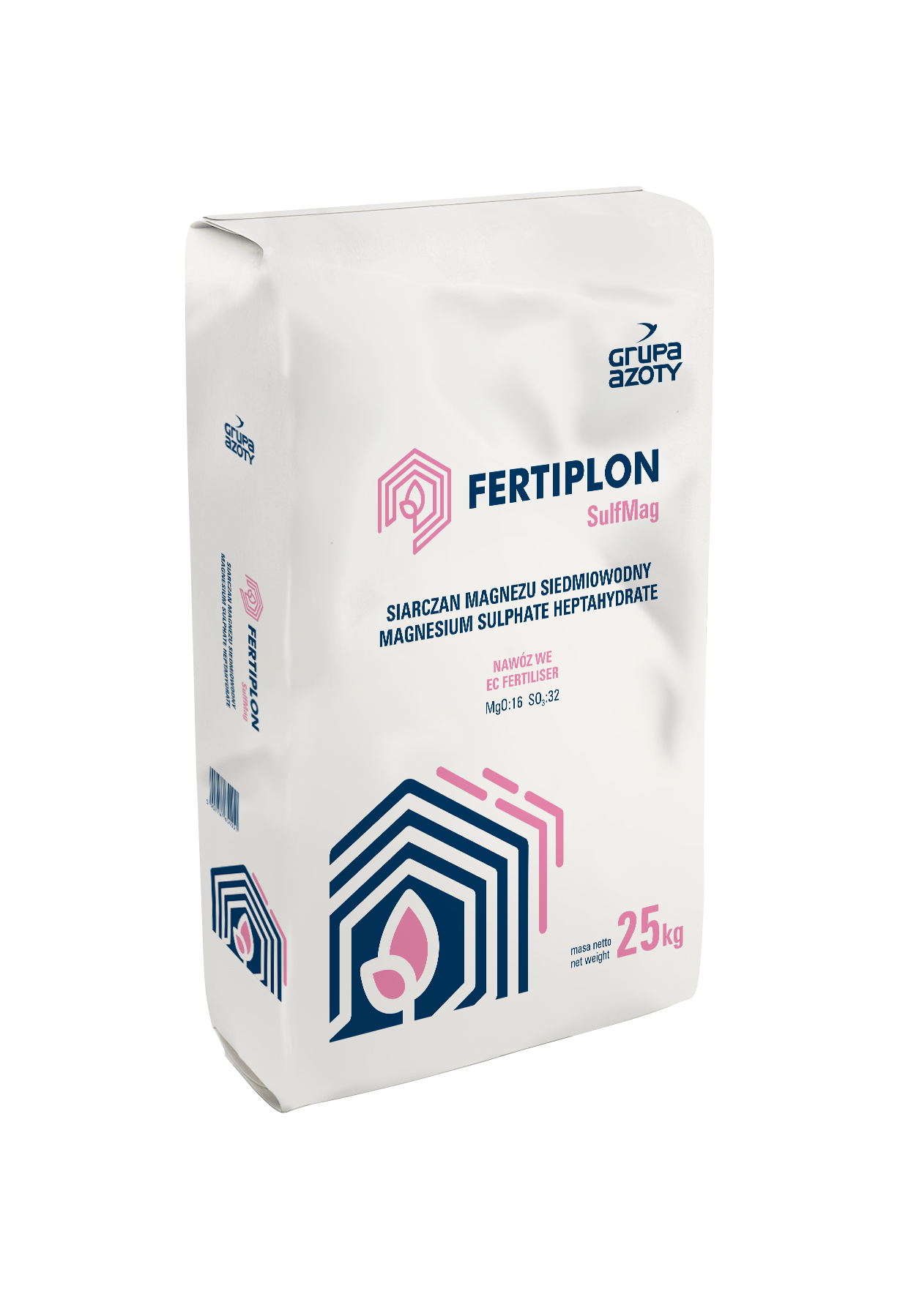Grupa Kapitałowa Grupa Azoty
Choose a company

FERTIPLON SULFMAG Magnesium sulphate heptagydrate is a high-quality, crystalline fertilizer that contains magnesium and sulphur, is completely soluble in water, and does not contain any without foreign matter. universal fertilizer for all arable crops. Used in agriculture, horticulture and gardening.
| Nutrients | % (m/m) |
| Main component, MgSO4 x 7 H2O | At least 99.5 |
| Magnesium compounds soluble in water (MgO) | At least 16.2 |
| Magnesium (Mg) | At least 9.8 |
| Sulphur (S) | At least 12.9 |
| Iron content (Fe+3) | No more than 0.0020 |
| Chlorides (Cl-) | No more than 0.03 |
| Arsenic (As) | No more than 0.0002 |
| Magnesium content (MgSO4) | At least 48.59 |
| Content of heavy metals (Pb+2) | No more than 0.0001 |
| Cadmium (Cd) | No more than 0.0002 |
Packaging

Storage



| Crop | Application time | Application rate (kg/ha) | Recommended number of applications | Recommended quantity of spray liquid (L/ha) |
| Solanaceous vegetables: tomato, pepper | 5th – 8th true leaf on main stem unfolded | 6 – 10 | 1 | 300 – 500 |
| 1st – 3rd flower open on main stem (BBCH 61 – 63) | 6 – 10 | 1 | 300 – 500 | |
| 1st – 3rd fruit on main stem has reached typical size and form (BBCH 71 – 73) | 6 – 10 | 1 | 300 – 500 | |
| 4th – 6th fruit on main stem has reached typical size and form (BBCH 74 – 76) | 6 – 10 | 1 | 300 – 500 | |
| Cucurbits: pumpkin, cucumber, zucchini | 6 – 9 or more leaves on main stem unfolded (BBCH 16 - 19) | 6 – 10 | 1 | 300 – 500 |
| 2nd – 6th primary side shoot visible (BBCH 22 – 26) | 6 – 10 | 1 | 300 – 500 | |
| 6th – 7th flower initial with elongated ovary visible on main stem (BBCH 56 – 57) | 6 – 10 | 1 | 300 – 500 | |
| Bulb vegetables: onion, garlic | 3rd – 6th leaf visible (BBCH 13 – 16) | 6 – 10 | 1 | 300 – 500 |
| Development of harvestable vegetative plant parts (BBCH 41 – 42) | 6 – 10 | 1 | 300 – 500 | |
| Bulb reaches 30 - 50% of typical diameter (BBCH 43 – 45) | 6 – 10 | 1 | 300 – 500 | |
| Root vegetables: carrot, parsley, celery, beetroot | 3 – 4 leaves unfolded (BBCH 13 – 14) | 6 – 10 | 1 | 300 – 500 |
| Root reaches 30 - 50% of typical diameter (BBCH 43 – 45) | 6 – 10 | 1 | 300 – 500 | |
| Leafy vegetables: head cabbage, savoy cabbage, cauliflower, broccoli | Heads begin to form (BBCH 41) | 6 – 10 | 1 | 300 – 500 |
| Head reaches 40 - 50% of typical size (BBCH 44 – 45) | 6 – 10 | 1 | 300 – 500 | |
| Head reaches 60 - 80% of typical size (BBCH 46 – 48) | 6 – 10 | 1 | 300 – 500 | |
| Legumes: peas, beans | 1-5 internode(s) visible (BBCH 31 – 35) | 6 – 10 | 1 | 300 – 500 |
| Pome-fruit trees: apple tree, pear tree | Flower buds visible – green buds (BBCH 55 – 56) | 7.5 – 16 | 1 | 500 – 800 |
| Flowers fading: majority of petals fallen (BBCH 67) | 7.5 – 16 | 1 | 500 – 800 | |
| Fruit reaches a size of 10 - 20 mm (BBCH 71 - 72) | 7.5 – 16 | 1 | 500 – 800 | |
| Fruit development – fruit reaches 90% of typical size (BBCH 73 – 79) | 7.5 – 16 | 1 | 500 – 800 | |
| Stone-fruit trees: sour cherry, cherry, plum, peach, apricot | White bud – most flowers with petals forming a hollow ball (BBCH 57 – 59) | 5 – 12 | 1 | 500 – 800 |
| Flowers fading: majority of petals fallen (BBCH 67 – 69) | 5 – 12 | 1 | 500 – 800 | |
| Green ovary surrounded by dying sepal crown (BBCH 72) | 5 – 12 | 1 | 500 – 800 | |
| Directly after harvest | 5 – 12 | 1 | 500 – 800 | |
| Berry plants: autumn raspberry, currant | End of dormancy – leaf development | 3 – 7.5 | 1 | 300 – 500 |
| Shoots about 50% of final length | 3 – 7.5 | 1 | 300 – 500 | |
| First shoots of final length | 3 – 7.5 | 1 | 300 – 500 | |
| Beginning of flowering | 3 – 7.5 | 1 | 300 – 500 | |
| Growth and ripening of fruits – to the first harvest | 3 – 7.5 | 1 | 300 – 500 | |
| Agricultural crops | ||||
| Wheat | Leaf development – tillering (BBCH 11 – 29) | 10 – 15 | 1 | 200 – 300 |
| Stem elongation (BBCH 30 – 37) | 10 – 15 | 1 | 200 – 300 | |
| Barley | 3 leaves unfolded – beginning of stem elongation (BBCH 13 – 32) | 10 – 15 | 1 | 200 – 300 |
| Flag leaf stage – first awns visible (BBCH 39 – 49) | 10 – 15 | 1 | 200 – 300 | |
| Rye | leaves unfolded – beginning of stem elongation (BBCH 13 – 32) | 10 – 15 | 1 | 200 – 300 |
| Flag leaf stage – beginning of heading (BBCH 39 – 51) | 10 – 15 | 1 | 200 – 300 | |
| Oat | 3 leaves unfolded – beginning of tillering (BBCH 13 – 22) | 10 – 15 | 1 | 200 – 300 |
| Beginning of stem elongation – flag leaf stage (BBCH 30 – 39) | 10 – 15 | 1 | 200 – 300 | |
| Maize | 2 – 6 leaves unfolded (BBCH 12 – 16) | 10 – 15 | 1 | 200 – 300 |
| 7 – 8 leaves unfolded (BBCH 17 – 18) | 10 – 15 | 1 | 200 – 300 | |
| 1st node – beginning of tassel emergence (BBCH 31 – 51) | 10 – 15 | 1 | 200 – 300 | |
| Oilseed rape | 4 leaves unfolded – 1 node visible (BBCH 14 – 31) | 10 – 15 | 1 | 200 – 300 |
| Development of flower buds – yellow buds (BBCH 50 – 59) | 10 – 15 | 1 | 200 – 300 | |
| End of flowering stage – 30% of pods have reached their typical size (BBCH 69 – 73) | 10 – 15 | 1 | 200 – 300 | |
| Sugar beet | 4 – 7 leaves unfolded (BBCH 14 – 17) | 10 – 15 | 1 | 200 – 300 |
| 8th leaf unfolded – beginning of crop cover (BBCH 18 – 31) | 10 – 15 | 1 | 200 – 300 | |
| Leaves cover 20-40% of ground (BBCH 32 – 34) | 10 – 15 | 1 | 200 – 300 | |
| Potato | 3 – 6 leaves on main stem unfolded (BBCH 13 – 16) | 10 – 15 | 1 | 200 – 300 |
| First side shoots visible – 80% of plants meet between rows (BBCH 21 – 38) | 10 – 15 | 1 | 200 – 300 | |
| Tuber initiation (BBCH 40 – 41) | 10 – 15 | 1 | 200 – 300 | |
| 20-60% of total final tuber mass reached (BBCH 42 – 46) | 10 – 15 | 1 | 200 – 300 | |
